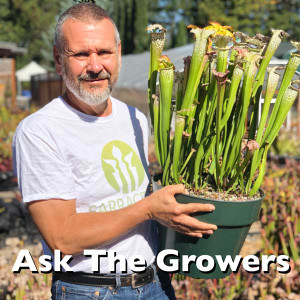April 7, 2023
Q/A #66 - Best Plant for Yellow Jackets?
QUESTION:
I live here in Portland and was referred to you on a recent visit to Leach Botanical Garden. I’ve been inundated with yellow jackets and wasps and someone at the garden suggested I get the yellow pitcher plant,
Sarracenia flava. I have a few questions.
- Will these indeed feast on the pesky insects and not eat my mason bees?
- Will one plant take be sufficient in my very small city yard?
- Is it the best (hungriest) variety of Sarracenia?
- Is this a good time of year to plant one?
Any help you can offer about adding this fascinating plant to my garden and helping eliminate the yellow jackets will be much appreciated!
(Submitted in April 2019.)
RESPONSE BY JEFF DALLAS:
Sarracenia flava is a very good plant for yellow jackets, but some others may be better. The reason for this is that flava is an early season Sarracenia and is sometimes in decline when yellow jackets are at their peak. Better candidates are
- S. alata,
- S. alata x minor,
- S. alata, Red Hood,
- S. alata x leucophylla,
- S. Judith Hindle
- S. leucophylla, Tarnok
Can I guarantee they won't eat your mason bees or any bees? No, I can't guarantee that. In late summer, they do catch bees sometimes. The more colorful ones are worst about this, and the pure green varieties least so. The bees they do capture, however, are mostly drones that got kicked out of the hive.
How many plants will you need to take care of the yellow jackets? There's no way to know. This also gets into an area that I often caution people about. It's the "I have this bug problem. Which plant will cure it?" My answer is always, "None of them". Carnivorous plants, especially Sarracenia, do catch plenty of insects. But will they eliminate a pest problem? Probably not. I always like to say the best reason to grow them is that you enjoy plants and want something unusual to add to your collection. If the only reason you want one is bug control, you will always be disappointed.
Spring is the best time of year to get one. They are just coming out of dormancy and will have full growth by early June. Wherever you are thinking of placing one, you need to have a full sun exposure for it. It will always be a container plant since they cannot be planted in regular soil. They grow in peat moss. Please read our Sarracenia care guide for details about sunlight, water, soil, and winter dormancy.
• The original question and response have been edited for publication.
• With a database of thousands of questions, we will post a Q&A every few days or so.
• To search for similar posts, click on a hashtag below or use the site's search function.
• To submit a carnivorous plant question, visit Ask the Growers.

